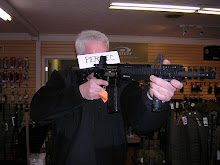I've been pondering this question for a couple of days now, and I don't have a good answer. I was watching Wednesday Night at the Range on The Outdoor Network-might as well, there's rarely anything else worth watching on Wednesdays-and caught the "Best Of" episode that was the season finale of Shooting Gallery. That episode centered on Rob Pincus' Combat Focus Shooting.
I watched it in hopes of finally finding out what was different, other than a couple of shooting positions, about CFS. Looks to me like it's no different, except for a couple of TTP's, than the way everybody should be doing it anyway: thumbs forward isosceles. Don't jerk the trigger. They don't focus on the front sight, which is different from the way the best shooters in the world are taught, but the show didn't go into what to focus on instead.
Basically, I'm trying to figure out what's different and better about CFS than the way the best combat shooters in the world are trained. I'm not seeing it. Additionally, I don't see a reason to listen to what Rob Pincus has to say in contrast to what Larry Vickers, Kyle Lamb or Pat Rogers does. I know their backgrounds. Rob Pincus' background is a lot less clear.
Subscribe to:
Post Comments (Atom)




6 comments:
THanks for watching the show.... In terms of the mechanics and shooting fundamentals, I think you are right... there isn't a lot of difference between CFS and most progressive schools (ie- non-weaver).
When people ask the "what's different" question, I generally have 2 answers:
1. We start with unsighted fire (focusing on the threat, as was covered by Paul, one of the instructors on the show) instead of sighted fire. We believe it is a more intuitive way to get comfortable with shooting rapidly for a new shooter and it is a more important defensive shooting school. We then add the use of sights, to be used when needed....
2. We focus on "counter ambush" scenarios, not shooting while we are in control (ie- hunting, range practice, etc). The idea here is that we are not trying to "be the best shooter" we can be out of context of a fight... you might be more accurate in a weaver stance, but the time-effort-energy required to get into one negates the value the majority of the time.
Thanks again for your interest in the program and the chance to comment. If you interested in other explanations, you might try the first episode of the Combat Focus Podcast (itunes, etc...).
-RJP
Thanks for the clarification! I guess I missed the "focus on the target" aspect. I was looking for that to be expounded on, but I guess I just missed it or misunderstood it. I'm not sure I'm down with it, but at least I understand a lot better now. Thanks!
No problem, man... I appreciate someone asking questions instead of simply passing judgement without all the info....
It is tough to try to get everything out in such a short timeframe (less than 22 minutes of airtime!)... I actually just saw the show for the first time late last night off the DVR and was disappointed with some of the edits... not their fault, really... just a ton of info I'd like to see go out to answer what I am sure people have as questions.
Thanks Again.
-RJP
Thanks for taking the time to answer them!
Whoa what a terrific response!
I think I get it, but I need to attend a school. Awerbuck is nearby at Reed's - but otherwise, I really don't know much about what's available out here.
It takes a good bit of study, and it helps to have an idea of what it is you want to learn. For instance, when Larry Vickers' website describes a basic class, that's not really what you're getting. You have to have a base of knowledge and be able to shoot OK before you get there, or the class will be blowing by. The description reads like a beginning class, but it's really not. That's where the Intarweb comes in handy!
Post a Comment